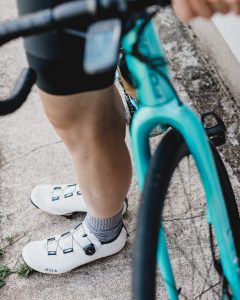bike frame size – how to choose the correct bike size
- Michael
- Last Updated August 27, 2023
We are a reader supported site. We earn commissions when you buy through links on our site. Learn more.
Before I knew how important it is to choose the correct bike frame size for my body, I always wondered why my rides were so uncomfortable.
After leg cramps, lower back pain, and general frustration with my bike, I realized that I had neglected to consider my height when I chose my bike. So, I’ve put together this guide to keep you from making the same mistake.
What Size Bicycle is Right for My Height?
Getting the appropriate bike frame size for your height is crucial to your comfort during the ride and the bike’s performance.
Believe me; I know how frustrating it is to end a ride with bruised knees because of how much they were bumping up against the handlebars.
On the other hand, I’ve also dealt with my fair share of soreness and cramps from straining to reach the pedals on a frame that was way too big for me.
No matter how high-quality your bike is, no manufacturer can overcome the all-too-common consumer mistake of getting an inappropriately sized frame.
This is precisely why suppliers include a sizing chart with their bikes. You can reference these charts either in-store or online before you commit to a purchase. Here’s are some of the most widely accepted guidelines to correctly estimate a suitable bike frame in consideration of your height:
| Height | Bike Frame |
| 4’11”-5’3″ | 13″-15″ (XS) |
| 5’3″-5’7″ | 15″-17″ (S) |
| 5’7″-5’11” | 17-19″ (M) |
| 5’11”-6’2″ | 19″-21″ (L) |
| 6’2″-6’4″ | 21″-23″ (L/XL) |
| 6’4″+ | 23″+ (XL) |
When using this guide, don’t worry if your height doesn’t exactly fall into these categories. This is not an exact science. If you’re worried about making a mistake in sizing, you have two options:
-
Get some help sizing your bike frame in-store. The bike shop experts will either ask for your height or measure you and guide you in shopping from there. They know the ins and outs of what you need for specific categories of bikes, too. For example, mountain bikes require 2-4″ of clearance, while road bikes need 1-2.”
- Note: “Clearance” refers to the distance between your body and the bike when you’re standing over the frame, specifically over the effective top tube (ETT). Too little clearance means the bike is too big. Too much, and it’s way too small.
-
Round up. Imagine that you’re not quite 5’11”, but you’re closer to that measurement than you are to 5’7″. In that case, you’ll need to round up to a 19″ bike frame. This way, the worst-case scenario is that the bike frame is a smidge too big, then you can just adjust your seat height.
- Note: Of course, if your height falls directly in the middle of the listed range, it’s safe to say that the median bike size is right for you. For example, if you’re 5’9″, you’ll probably be just fine with an 18″ bike frame.
Sizing Considerations for Various Bike Types
As mentioned previously, different categories of bikes follow varying standards for bike frame sizing. So, if you’re used to riding a road bike, I don’t recommend looking for the exact same bike frame size when transitioning to mountain bikes.
Further, bike frame sizes may run large or small depending on the manufacturer. This said, you really need to do your research or consult professional help before you commit to buying a specific model.
Here are some specifics for measuring the right frame size per type:
- Road bike: With these bikes, the ETT might either be sloping or straight. If it’s straight, then you need to have just about 1″ of clearance. On the other hand, compact road bikes with sloping ETTs require 2″ of clearance.
- Mountain bike: These can also have either straight or sloping tubes, but the guidelines are slightly different due to the possible addition of full suspension. In general, you should have 2″ of clearance. However, it’s okay for this to range between 1-2″ since the suspension will compress once you sit down.
- Hybrid bike: The rules for these vary, but generally, you can follow road bike standards. This mostly applies to commuters since bikes like beach cruisers are designed to let you step through and have your feet touch the ground no matter what.
Should Your Feet Touch the Ground on a Bike?
When you sit on your bike, both of your feet should be able to touch the ground comfortably.
No, this doesn’t mean that you can barely make contact with the floor via your tippy toes. If this is the case, your bike is too tall for you.
However, you shouldn’t be able to rest the entire surface of the bottom of your foot on the ground either. Only the ball of your foot should make contact with the floor without straining.
If you can place your entire foot on the floor, and worse, if your knees are bent while doing it, your bike is way too small. This will inevitably lead to horrible posture while you ride, resulting in back pain, excessive strain, poor bike performance, and an overall negative experience for you.
Note that these issues are not always indicative of a problem with the bike frame size, but may signal issues with your saddle. Try adjusting the seat up and down. If the problem persists, then you can safely conclude that you need to scale up or down for the frame.
Should Your Legs Be Straight When Riding a Bike?
Although your legs should be able to extend straight out when you straddle the bike frame, they should not be straight as you’re actively pedaling.
Your legs should only bend at a slight angle when riding your bike, ideally 25-35 degrees. Here are a few steps you can take to make sure you get the proper frame when sizing up a bike in store:
- Test the bike on a trainer by pedaling for a few minutes.
- Stop mid-pedal, specifically at the bottom of the revolution (when your leg is extended to the furthest point).
- Measure your knee’s angle or have someone measure it for you.
- If the angle does not fall between 25-35 degrees, adjust the saddle as necessary or swap out the bike for an appropriately sized frame.
- Note: Your leg should only extend to about 80-90% of its full length.
- Try pedaling again and this time, monitor your hips’ behavior. If your hips are rocking, see Step 4 for adjustments.
Another general rule of thumb, when your foot is in the three o’clock position mid-pedal, your knee should be perfectly in line with the ball of your foot.
In this position, your shin should be slightly angled forward. If your knee is too far forward and your shin is sharply angled, then it’s likely that the frame is too small for you, as your leg should not be bending so harshly in this position.
How Do I Determine Bike Frame Size?
Another method you can use to ensure that you’ve got the correct frame size is to lean your bike up against a wall, mount it, and use a similar leg extension test to the one above. A technique I recommend from the Global Cycling Network is as follows:
- Lean your bike up against a wall. Leave room for you to rotate the pedal.
- Mount the bike and position both your hands on the handlebars.
- Position one pedal (the one that’s not against the wall) in the 6 o’clock position.
- Place your heel on the pedal. Please make sure that you’re placing the right part of your foot onto the pedal, as you should be able to extend your leg fully at this point. The opposite foot should not be on the floor or touching its corresponding pedal.
- Readjust so that the ball of your foot is on the pedal and place your other foot on its pedal.
- Rotate the pedals backward for one full revolution. Your leg should be extended again, but there should be a slight bend at the knee this time.
This method is also useful for determining the appropriate saddle height. That said, I suggest using the above techniques for measuring your bike in-store before you buy it, then following up with these instructions at home to perfect the saddle height.
Read More: Bike Seat Height – How To Set The Saddle Height On Your Bike.
Lastly, understand that the type of bike you’re buying will directly influence the height and size you’re looking for when using any of the methods discussed here.
For example, if you mostly plan on riding around the city, you might want something that’s shorter and higher. On the other hand, professional cyclists and racers are more likely to opt for longer frames with lower profiles.
Whichever option you choose, please make sure that your back is straight and your legs are appropriately extended. These considerations will help prevent medical issues like cervical strains, lower back pain, and knee problems.
Summary
It is vital that you get the appropriate bike frame size for your height when you purchase a new bike.
The best ways to do this are to consult the manufacturer’s size chart, ask a professional for help, and test the bike on a trainer before buying it.
By using the methods described here, you’ll reduce your chances of injury and improve your cycling experience, no matter the terrain.

Michael
Hi, my name is Michael and I'm the chief editor of this website.
I've been riding all sorts of bikes for over a decade now and don't plan on stopping anytime soon.
Everyday, I learn new things and want to share my experiences with others.
Ready to join me on my journey?






